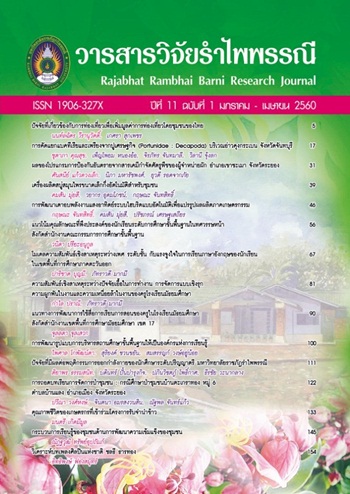ความสัมพันธ์เชิงสาเหตุระหว่างปัจจัยเอื้อในการทำงาน การจัดการแบบเชิงรุก ความผูกพันในงานและความเหนื่อยล้าในงานของครูโรงเรียนมัธยมศึกษา
Main Article Content
บทคัดย่อ
การวิจัยนี้มีวัตถุประสงค์เพื่อพัฒนาโมเดลความสัมพันธ์เชิงสาเหตุระหว่างปัจจัยเอื้อในการทำงาน การจัดการแบบเชิงรุก ความผูกพันในงานและความเหนื่อยล้าในงานของครูโรงเรียนมัธยมศึกษาและตรวจสอบความสอดคล้องของโมเดลกับข้อมูลเชิงประจักษ์ กลุ่มตัวอย่างเป็นครูที่สอนในโรงเรียนมัธยมศึกษา สังกัดสำนักงานเขตพื้นที่การศึกษา มัธยมศึกษา เขต 17 จังหวัดจันทบุรีและจังหวัดตราด ปีการศึกษา 2558 จำนวน 500 คน ได้มาจากการสุ่มแบบหลายขั้นตอน เครื่องมือที่ใช้ในการวิจัยเป็นแบบสอบถามลักษณะเป็นมาตรประมาณค่า 5 ระดับ วิเคราะห์ค่าสถิติพื้นฐาน ค่าเฉลี่ย ร้อยละ และวิเคราะห์โมเดลสมการโครงสร้างด้วยโปรแกรม LISREl 8.80
ผลการวิจัย ปรากฏว่า โมเดลความสัมพันธ์เชิงสาเหตุระหว่างปัจจัยเอื้อในการทำงาน การจัดการแบบเชิงรุก ความผูกพันในงานและความเหนื่อยล้าในงานของครูโรงเรียนมัธยมศึกษา ที่พัฒนาขึ้น แสดงให้เห็นว่า ความผูกพันในงานและปัจจัยเอื้อในการทำงานเป็นสาเหตุทางตรงของความเหนื่อยล้าในงาน ปัจจัยเอื้อในการทำงานและการจัดการแบบเชิงรุกเป็นสาเหตุทางอ้อมโดยส่งผ่านความผูกพันในงาน โมเดลที่พัฒนาขึ้นมีความสอดคล้องกับข้อมูลเชิงประจักษ์อยู่ในเกณฑ์ดี ค่าสถิติไค-สแควร์ เท่ากับ 98.94, ค่า df เท่ากับ 97, ค่า p เท่ากับ .43, ดัชนี GFI เท่ากับ .97 ค่า SRMR เท่ากับ .03 และค่า RMSEA เท่ากับ .01 ตัวแปรทั้งหมดในโมเดลสามารถอธิบายความแปรปรวนของตัวแปรความเหนื่อยล้าในงานของครู ได้ร้อยละ 87
Article Details
เอกสารอ้างอิง
2. ศิรินันท์ กิตติสุขสถิต. (2556). คุณภาพชีวิตการทำงานและความสุข. กรุงเทพมหานคร: ธรรมดาเพรส.
3. Bakker, A. B., Demerouti, E., & Schaufeli, W. B. (2005). The crossover of burnout and work engagement among working couples. Human Relations, 58(5): 661-689.
4. Bakker, A. B., & Demerouti, E. (2008). Towards a model of work engagement.Career development international, 13(3): 209-223.
5. Bakker, A. B., & Bal, M. P. (2010). Weekly work engagement and performance: A study among starting teachers. Journal of Occupational and OrganizationalPsychology, 83(1): 189-206.
6. Bermejo, L., Hernández-Franco, V., & Prieto-Ursúa, M. (2013). Teacher Well-being: personal and job resources and demands. Procedia-Social and Behavioral Sciences, 84: 1321-1325.
7. Cherniss, C. (1992). Long-term consequences of burnout: An exploratory study. Journal of organizational Behavior, 13: 1-11.
8. Cooper-Thomas, H. D., Paterson, N. L., Stadler, M. J., & Saks, A. M. (2014). The relative importance of proactive behaviors and outcomes for predicting newcomer learning, well-being, and work engagement. Journal of Vocational Behavior: 84(3): 318-331.
9. Greenglass, E. (2004). Coping with the threat of severe acute respiratory syndrome: Role of threat appraisals and coping responses in health behaviors. Asian Journal of Social Psychology, 7(1): 9-23.
10. Jackson, S. E., Schwab, R. L., & Schuler, R. S. (1986). Toward an understanding of the burnout phenomenon. Journal of applied psychology, 71(4): 630.
11. Roslan, N. A., Ho, J. A., Ng, S. I., & Sambasivan, M. (2015). Job Demands & Job Resources: Predicting Burnout and Work Engagement among Teachers. International Proceedings of Economics Development and Research, 84: 138-144.
12. Saks, A. M. (2006). Antecedents and consequences of employee engagement. Journal of managerial psychology, 21(7): 600-619.
13. Schaufeli, W. B., Salanova, M., González-Romá, V., & Bakker, A. B. (2002). The measurement of engagement and burnout: A two sample confirmatory factor analytic approach. Journal of Happiness studies, 3(1): 71-92.
14. Schaufeli, W. B., & Bakker, A. B. (2004). Job demands, job resources, and their relationship with burnout and engagement: A multi‐sample study. Journal of organizational Behavior, 25(3): 293-315.
15. Van Beek, I., Taris, T. W., & Schaufeli, W. B. (2011). Workaholic and work engaged employees: dead ringers or worlds apart?. Journal of Occupational Health Psychology, 16(4): 468.


